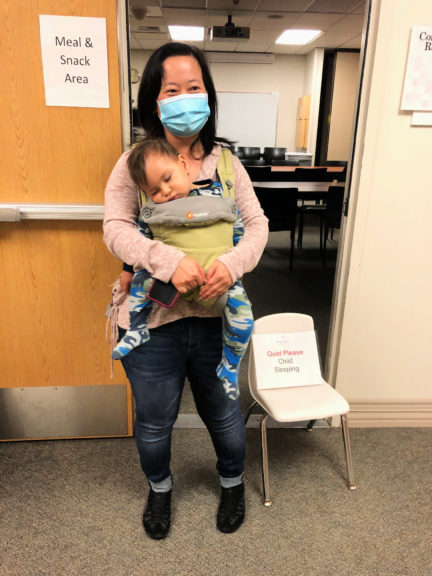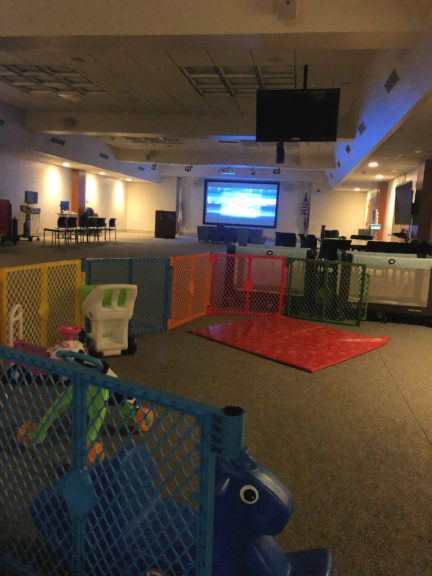Rocking babies to sleep, logging kids onto Zoom school lessons, and coloring with preschoolers – these activities were all in a day’s work for CHOC child life team as they ran a pop-up on-campus daycare center for children of hospital staff during the COVID-19 emergency this spring.
“It brought me back to my early days as a parent,” says Amber Chavez, a special programs coordinator for the Cherese Mari Laulhere Child Life Department.
That the child life department could ultimately be tasked with setting up on-campus childcare for hospital staff in the event of a large-scale disaster or crisis was well-known among the team. They had long planned for that possibility, stocking up bins of activities and supplies carefully marked by age group – just in case.
So, when schools in Orange County, Calif., began closing on-campus instruction in mid-March, the team sprang into action immediately.
A survey conducted through CHOC’s emergency communication system revealed that nearly 600 staff and physicians did not have backup childcare. Then, the child life team, in collaboration with executive leadership and other departments, scurried over the weekend to establish an on-campus daycare for physicians and staff who directly support patient care and throughput and had no other childcare options.

Just in time
Within 72 hours of receiving notices of school campus closures, the center had an emergency operating license, and was open and available in a conference center of the main hospital campus.
In addition to a robust programming schedule, the compound featured a space for naps, a play area, computer stations for school-aged children, a diaper-changing area, and anything that could possibly be needed to care for children of a wide age range while their parents worked in the hospital.
“CHOC providing these services was heaven-sent,” says Dr. Sonia Morales, a hematology/oncology fellow who enrolled her daughter. “It made a very stressful time less stressful. There is no greater feeling than having your child squeal with excitement when she’s being dropped off.”
The team quickly established a schedule and routine – and support from many other hospital departments was critical.
Older children would get checked-in, their backpacks placed in a cubby and any upcoming Zoom class appointments set as an alarm on a phone. After enjoying breakfast provided by food services, the children could play video games for a bit sometimes – to their delight – broadcast on the center’s large screen. A team of CHOC physical therapists would come by twice daily to lead the kids of all ages through activities and movement exercises.
“We tried our best to support the kids through this difficult time as well,” says Eric Mammen, the child life department’s creative arts supervisor, who helped develop the daycare’s schedule and oversee day-to-day operations. “We also helped with homework when needed and I had to learn how to do elementary math and English again. I admit I had to use Google a few times helping the kids with their homework.”

A true collaboration
The project was truly a collaboration between many departments across the health system, including environmental services, food services, legal services, patient care services, human resources, information systems, plant operations, regulatory, safety and security, and volunteer services.
And the result was a daycare center that provided wonderful care, structure and fun – not to mention peace of mind for many CHOC working parents who could rest assured their children were safe and happy while they supported patients.
Little Diego Valencia had never been in daycare before he came to CHOC’s center, says his mother, Jamie, a nurse in the recovery center.
“He will remember all of them forever,” she says. “Without child life’s kind hearts, I would not have been able to work. It was easy to leave Diego in their care because they took such good care of him.”
Being able to check on and nurse her young daughter has been a relief for Dr. Bhavita Patel, a hematology/oncology fellow.
“I cannot say enough about the phenomenal child life staff taking care of our children,” she says. “Bless them for their diligence and flexibility during this time. It takes a village, and they have quickly become a crucial part of mine. My anxiety and overall mental health have improved drastically as a result.”
An exercise in agility
Running the center was also an exercise in agility for the child life department, requiring the team to quickly adapt and make changes to meet evolving needs.
The compound’s layout and schedules were adjusted occasionally when needed. Child life specialists made quick dashes to a nearby drug store for nightlights after noticing the windowless conference center was too dark for little ones to nap without fear. Plant operations were called in after realizing an overhead page could thwart a half hour’s work to rock a baby to sleep.
While already a close-knit team, the child life team grew more bonded after the experience.
“It wasn’t easy, but we grew stronger as a department and team,” Amber says. “We lifted each other up when times were tough, and we laughed in times of need.”
Earlier this month, the center’s operations transitioned to a national childcare chain. And though the child life team has transitioned back to their more typical work, the team might be feeling a touch of separation anxiety.
“The child life staff bonded with the children and they looked forward to seeing everyone,” Eric says. “I think it is safe to say that we will all look at the Wade Center a little differently now.”
Learn more about the CHOC Cherese Mari Laulhere Child Life Department.




